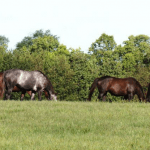Grazing Systems for Horses: Continuous and Rotational

When managed properly, pastures can satisfy the energy demands of many horses. One aspect of pasture management involves the length of time horses are allowed to graze a given plot. A group of researchers recently compared continuous and rotational grazing systems in terms of forage production and environmental factors.
The study, conducted over 27 months and three grazing seasons, was set up so that horses in the rotational grazing group were permitted to graze 50% of the time. When not grazing, horses were maintained in drylots and fed 2% of body weight in quality grass hay. Horses continuously grazing were only offered supplemental hay when grass was depleted.
Both groups of horses maintained an appropriate body condition score (BCS) throughout the study. Horses that were continuously grazed had a higher BCS of 6.3 compared to 5.9 in the rotational grazing group.
“An ideal BCS for most sport horses and breeding horses is 5-6. Body condition scores of 7 and above are considered overweight and obese, which can predispose horses to metabolic conditions, especially if this higher BCS is maintained year-round,” said Catherine Whitehouse, M.S., a Kentucky Equine Research nutrition advisor.
The researchers noted that rotational grazing practices such as the one used in this study are advantageous for owners trying to control their horse’s weight and avoid obesity.
“Overweight and metabolic horses require restricted pasture grazing to help with weight maintenance. In some cases, grazing may even be prohibited. Owners that manage horses on pasture 24/7 without access to a sacrifice or drylot area should consider adopting management strategies such as grazing muzzles or strip grazing to help reduce pasture intake,” Whitehouse recommended.
Without access to fresh pasture, some horses may require a low-intake concentrated source of vitamins and minerals to help balance their diets.
Pastures in the rotational groups had higher proportions of total vegetative cover and planted grasses (e.g., tall fescue and orchardgrass) compared to the continuously grazed pastures. The pastures in the rotational group had fewer weeds, bare ground, rocks, and litter compared to the continuously grazed pastures. Sward height and herbage mass were greater in the rotational pastures.
“The continuously grazed pastures suffered damage due to trampling and overgrazing in only three grazing seasons. The pastures in the rotational grazing group, however, could be managed to mitigate these effects,” Whitehouse noted.
In addition, Whitehouse said that maintaining vegetative cover, 70% or higher throughout the pasture, helps minimize soil erosion and improves water quality.
No difference in maintenance costs was identified between the two groups. Maintenance included dragging the pastures to disperse manure and mowing ungrazed forage. Further, no difference in the amount of hay fed to each group differed, which means hay costs were similar.
“Regardless of grazing style, horse owners should monitor the pasture for adequate forage and supplement as needed with hay or concentrate feed to support body weight. Being proactive with diet changes during the fall months can help ensure horses enter the winter at an ideal weight and help minimize weight loss during this time.”
In sum, the researchers concluded, “The results here support the recommendation of rotational grazing for purposes of optimizing pasture yield and preventing deterioration of vegetative cover, which has important environmental and ecological implications.”
*Williams, C.A., L.B. Kenny, J.R. Weinert, K. Sullivan, W. Meyer, and M.G. Robson. 2020. Effects of 27 mo of rotational vs. continuous grazing on horse and pasture condition. Translational Animal Science 4(3).








